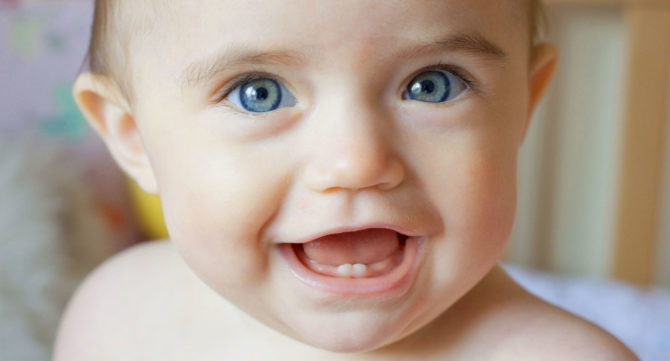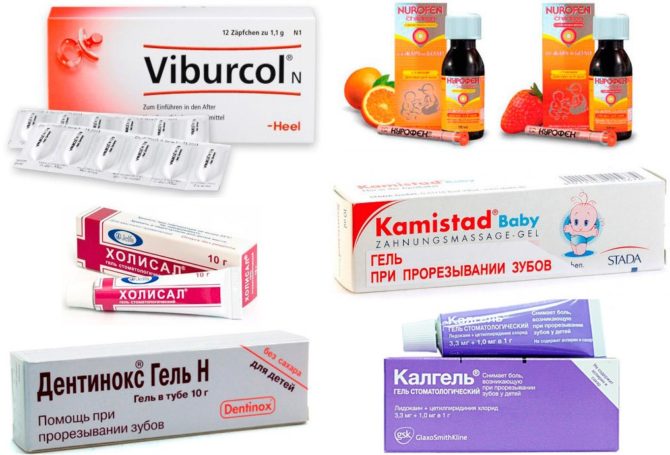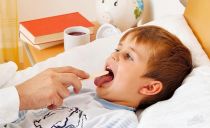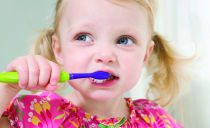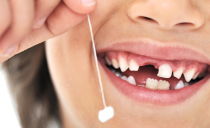How and how to help a child when his teeth are cut
No matter how much one wants to help the child when his teeth are being cut, he cannot completely anesthetize the gums. Severe anesthesia in infancy is contraindicated, and weak preparations will only slightly “cool” the inflamed tissue. But some pharmacy products can still help parents ease the process of teething and soothe the baby.
Content
Teething symptoms
Baby teeth begin to erupt at the age of 6 months. In girls, this process usually proceeds faster than in boys. Most often, the teeth come out with an interval of 1-2 months, but in some children they can begin to grow at the same time.
The main symptoms that indicate an early teething include:
- Anxiety and sleep disturbance
- frequent crying;
- heat;
- violation of the stool;
- gum redness;
- sore throat;
- copious salivation.
Before teething, the baby begins to pull toys into his mouth, sucks his fingers, cries a lot and calms down only when feeding.
First Aid for Teething
First aid for teething is competent anesthesia and distraction of the baby. You need to play with the child, you need to calm him down and lull him to sleep. If a woman refused breastfeeding, but she still has milk, it is better to restore feeding, as it helps to calm the baby. Breastfeeding is the best way to help a baby whose teeth are being cut.
To “scratch” and thereby anesthetize the gums of the baby, store teethers or ordinary hard vegetables and fruits will help. Before giving your child a teether toy, it is recommended that you briefly place it in the refrigerator. A cold object will relieve swelling of the gums and relieve pain for a short time.
You can help the baby whose teeth are being cut by lightly massaging his gums with clean fingers (you can with a drop of regular toothpaste). It is also recommended to use special silicone brushes for these purposes.
Medicines should be resorted to only if non-medications clearly do not help. There is no drug without side effects, so their use is not recommended.
Medications
When teething the first teeth are shown antipyretic, soothing and painkillers. The exact list of medications depends on the symptoms. With the help of medicines, you can help the child only temporarily, because pain from teething will occur until the baby has the last tooth. Therefore, each parent must evaluate the feasibility of taking short-acting medicines.
Antipyretic drugs
Antipyretic drugs are used if the child has a fever. You need to make sure that hyperthermia is not associated with any respiratory disease, otherwise an antipyretic medicine will smear the clinical picture and make further diagnosis difficult.
Classical antipyretic drugs include:
- Nurofen based on ibuprofen. It helps with teething, so it is the most commonly prescribed drug by pediatricians.
- Children's Panadol. The main side effect is swelling.
- Candles Tsefekon. It can be used only in the absence of allergy to paracetamol.
- Suspension Kalpol.
When choosing a form of an antipyretic, one should focus on the physiological characteristics of the child's body, for example, sweet syrups can cause a vomiting reflex in some children.
Sometimes pediatricians prescribe for babies whose teeth are being cut, Nise or Nimesulide, but these drugs should never be given to young children. The active substances in such medications adversely affect the kidneys and liver, leading to their irreversible changes. Even adults feel the side effect of Nimesulide (the medication is used as a complex therapy of dental diseases).
Anesthetics: homeopathy, gels, suppositories, syrups
All pain medication used for teething can be divided into:
- means of external use;
- medicines for oral administration;
- candles;
- homeopathic remedies.
Homeopathic remedies
Homeopathic medicines are medicines with unproven efficacy. They have a plant basis and practically do not have side effects, which makes it possible to use them for babies.
These medicines include:
- Candles Viburkol. Viburkol candles can be called the most convenient way to treat babies. In addition to the analgesic, this drug also has an antipyretic effect. Due to the plant base, it has no contraindications. The medicine has a strong sedative effect, so you should give it to your child in the evening, before bedtime. After alleviating the condition of the baby, it is recommended to reduce the dose of the drug to half the suppository.
- Dentokind. The basis of the drug is belladonna and chamomile flowers. In addition to the anesthetic effect, the drug relieves nervousness and helps in the fight against insomnia.
 Dantinorm. These tablets are given to infants by dissolving in milk or water. They can be used if, along with pruritus, the baby has gum swelling, fever and diarrhea. The product is made on the basis of rhubarb, chamomile and Indian ivy. It has no contraindications, except for individual intolerance to the components.
Dantinorm. These tablets are given to infants by dissolving in milk or water. They can be used if, along with pruritus, the baby has gum swelling, fever and diarrhea. The product is made on the basis of rhubarb, chamomile and Indian ivy. It has no contraindications, except for individual intolerance to the components.- Carmolis. Carmolis is a natural gel made on the basis of propolis and medicinal plants: chamomile, mint, cloves and others. The child will feel relief just a few minutes after applying Carmolis. Due to the presence of propolis and peppermint in the medicine, an infant may experience an allergy.
- Pansoral. Pansoral is a homeopathic topical preparation for infants. It well reduces swelling and itching of the gums when teething. Long-term use of the drug is fraught with side effects, so it is not recommended to use it for more than 5 days. The harm of the drug is due to the fact that it contains cetalkonium chloride and alcohol.
Means for external use
Anesthetic gels can be used for children of any age. They are well fixed on the gums, practically do not wash off with saliva and are easy to use.
The most famous pain reliever gels include:
- Kalgel with lidocaine, which can lead to temporary numbness of the baby’s tongue.
- Dentinox (it can be used from 4 months).
- Cholisal with the anti-inflammatory component choline.
- Dentol with benzocaine, which can be used no more than 7 days in a row.
- Kamistad - a leading analgesic for teething, is often prescribed for children who are diagnosed with candidiasis of the oral cavity.
The use of a therapeutic gel is the most effective way to quickly help a child when his teeth are cut. The medicine will instantly anesthetize the gums, but the analgesic effect will not last long: up to a maximum of 3 hours. When re-applying the gel, you must take into account the permissible dosage of the drug (how many times a day you can apply the drug, as indicated in the instructions).
After rubbing the drug into the painful gum, the child should not drink and eat, so it is better to apply the gel immediately before bedtime or after feeding.
The disadvantages of cooling gels include:
- a small number of acceptable applications;
- short-term effect;
- possible numbness of the mouth;
- burning immediately after application;
- increased salivation.
If a child accidentally swallows anesthetic gel, he may have difficulty breathing or swallowing. With frequent use, addiction can develop. Such medications are indicated for use when the baby's first teeth are cut, you can help the child with further teething with ordinary massage and special toys.
Oral Medicines
To anesthetize gums in infants, medication is indicated in liquid form. They are better absorbed into the bloodstream and act immediately after administration. When teething, drops of Fenistil and Parlazin are usually used. Fenistil is contraindicated in the presence of the following diseases:
- angle-closure glaucoma;
- bronchial asthma;
- violation of urination.
Parlazine is a powerful antihistamine and has serious anesthetic properties. The drug is contraindicated in children under 1 year old.
Candles
Suppositories for babies effectively help cope with inflammation, cramping and pain. Many of these drugs, in addition to the anesthetic, also have an antipyretic effect.
The most popular drugs:
- Paracetamol-based Panadol suppositories contribute to a gradual decrease in temperature and relieve unpleasant sensations. Anesthetic effect is manifested in an hour and a half after the introduction of the suppository.
- Efferalgan suppositories contain less paracetamol, which is why they are used even for newborns. They are recommended to be used when hyperthermia is observed along with pruritus from teething.
Any remedy from the above can help the baby with teething, but the exact choice should not be made by the parents, but by the attending physician. There are many fictional stories when the unauthorized use of a simple cooling gel led to the development of serious diseases in the child. Therefore, when choosing an analgesic for teething, you should seek help from a pediatrician.

